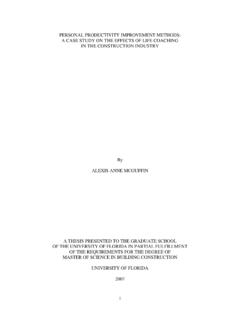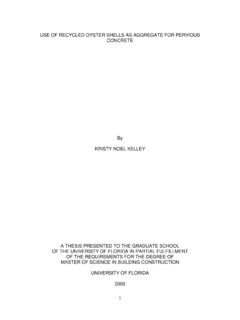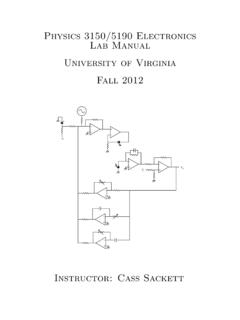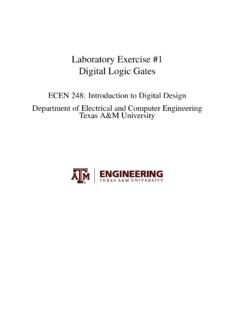Transcription of Introduction to Digital Logic with Laboratory …
1 Introduction to Digital Logicwith Laboratory ExercisesThis book is licensed under a Creative Commons Attribution LicenseIntroduction to Digital Logic withLaboratory ExercisesJames FeherCopyright 2009 James FeherEditor-In-Chief: James FeherAssociate Editor: Marisa DrexelProofreaders: Jackie Sharman, Rachel PuglieseFor any questions about this text, please email: Global Text Project is funded by the Jacobs Foundation, Zurich, SwitzerlandThis book is licensed under a Creative Commons Attribution LicenseIntroduction to Digital Logic with Laboratory Exercises2 A Global TextTable of The transistor and Logic of Logic Logic Morgan's design, construction and More Logic K-map placement on 't care on the mux ..32 Using a multiplexer to implement logical Timers and in Digital Memory.
2 State is a state machine?..49 State transition machine More state many bits of memory does a state machine need?..57 What are unused states?..5710. What's next?..64 Appendix A: Chip B: Resistors and book is licensed under a Creative Commons Attribution LicenseAppendix C: Lab D: Boolean E: Equipment series F: Solutions ..76 Chapter 1 review 2 review 3 review 4 review 5 review 6 review 7 review 8 review 9 review to Digital Logic with Laboratory Exercises4 A Global TextIndex of TablesTable 1: NAND 2: NOR 3: AB + 4: XOR 5: 4 input 6: 2 input 7: 3 input 8: f(A,B,C)..21 Table 9: g(A,B,C,D)..22 Table 10: h(A,B,C,D)..23 Table 11: h(w,x,y,z)..23 Table 12: Step 13: Step 14: Step 15: g(a,b,c)..33 Table 16: g(a,b,c).
3 33 Table 17: h(a,b,c,d)..34 Table 18: h(a,b,c,d)..34 Table 19: NOR SR 20: NAND SR 21: JK 22: T 23: D 24: Truth 25: Counter truth 26: Q1N(x,Q1,Q0)..53 Table 27: Q0N(x,Q1,Q0)..53 Table 28: Q1N(x,Q1,Q0) = Q1N = x' Q1'Q0' + xQ1' 29: Q0N(x,Q1,Q0) = xQ1'Q0' + x'Q1Q0'..58 Table 30: Q1N(x,Q1,Q0) = xQ1'Q0' + x'Q0 ..58 Table 31: Q0N(x,Q1,Q0) = xQ1'Q0' + x' 32: Truth table for 5 state 33: 34: 35: 36: Color book is licensed under a Creative Commons Attribution LicenseAbout the author and reviewersAuthor: James FeherJim currently teaches computer science at McKendree University in Lebanon, Illinois. He is a huge open sourcesoftware proponent. His research focuses on the use of open source software in theareas of hardware, programmingand networking.
4 His hobbies include triathlon, hiking, camping and the use of alternative energy. He lives with hiswife and three kids in St. Louis, MIssouri where he built and continues to perfect a solar hot water heating systemfor his : Kumud BhandariKumud graduated from McKendree University with degrees in computer science and mathematics. He hasworked at internships at the University of Texas and the Massachusetts Institute of Technology. He currentlyisemployed as a researcher with Argonne National : Andrew Van CampProfessor Van Camp is a retired electronics professor. In addition, he has extensive experience working andconsulting in industry. He currently resides in central Missouri where he continues his consulting for to Digital Logic with Laboratory Exercises6 A Global TextThis book is licensed under a Creative Commons Attribution LicensePrefaceThis lab manual provides an Introduction to Digital Logic , starting with simple gates and building up to statemachines.
5 Students should have a solid understanding of algebra as well as a rudimentary understanding of basicelectricity including voltage, current, resistance, capacitance, inductance and how they relate to direct currentcircuits. Labs will be built utilizing the following hardware: breadboards with associated items required such as wire, wire strippers and cutters some basic discrete components such as transistors, resistors and capacitors basic 7400 series Logic chips 555 timerDiscrete components will be included only when necessary, with most of the labs using the standard 7400 serieslogic chips. These items are commonly available and can be obtained relatively inexpensively. Labs will includelearning objectives, relevant theory, review problems, and suggested procedure.
6 In addition to the labs, severalappendices of background material are provided. Format for each chapterEach chapter is a combination of theory followed by review exercises to be completed as traditional homeworkassignments. Full solutions to all of the review exercises are available in the last appendix. Procedures for labs thenfollow that allow the student to implement the concepts in a hands on manner. The materials required for the labswere selected due to their ready availability at modest cost. While students would gain from just reading andcompleting the review exercises, it is recommended that the procedures be completed as well. In addition toproviding another means reenforcing the material, it helps to develop real world debugging and design skills.
7 This manual concentrates on the basic building blocks of Digital electronics: Logic gates and memory. It focuseson these items from the ground up. The reader will first see how Logic gates can be constructed from transistors andthen how Digital Logic functions are constructed using those gates. The concept of memory is then introducedthrough the construction of an SR latch and then a D flip-flop. A clock is created to be used in a basic state machinedesign that aims to combine Logic circuits with audienceThis text will be geared toward computer science students; however it would be appropriate for any studentswho have the necessary background in algebra and elementary DC electronics. Computer science students learnskills in analysis, design and debugging.
8 These skills are also used in the virtual world of programming, where nophysical devices are ever involved. By requiring the assembly and demonstration of actual circuits, students will notonly learn about Digital Logic , but about the intricacies and difficulties that arise when physically implementingtheir designs as well. Global Text ProjectEducation is the most powerful weapon you can use to change the world - Nelson MandelaThe goal of this text is to allow more students to gain access to this material by providing it in the CreativeCommons as well as specifying inexpensive materials to be used in the labs. For this reason the author chose toIntroduction to Digital Logic with Laboratory Exercises7 A Global TextPrefacework with the Global Text project to develop this text.
9 The Global Text Project will create open content electronictextbooks that will be freely available from a website. Distribution will also be possible via paper, CD, or DVD. Thegoal of the Global Text Project initially is to focus on content development and Web distribution, and work withrelevant authorities to facilitate dissemination by other means when bandwidth is unavailable or inadequate. Thegoal is to make textbooks available to the many who cannot afford work such as this would not be possible without the help of many. First, I would like to thank the Global TextProject for their vision of providing electronic textbooks for free to everyone. Marisa Drexel, Associate Editor at theGlobal Text Project provided countless suggestions and helpful hints for the document and for the creation of thedocument using OpenOffice.
10 Andrew Van Camp II, retired professor of electronics provided excellent suggestionsfor technical review of the content. Kumud Bhandari, currently a research aide at Argonne National Laboratory ,provided also provided technical review of the material. My students Evan VanScoyk, Samantha Barnes, and BenYork all provided helpful corrections and review as well as countless diagrams found in the document. I would liketp thank all of the countless open-source developers who produced such fine software as GNU/Linux, OpenOffice,the Gimp, and Dia which were all used to create this document. I am grateful to McKendree University forproviding support in the form of a sabbatical to allow me to complete this work. And I certainly wish to thank Sandywho provided excellent review suggestions, support and an extremely patient ear when I ran into trouble trying toincorporate a new feature from OpenOffice or attempted edit a particularly tricky book is licensed under a Creative Commons Attribution License0.



















